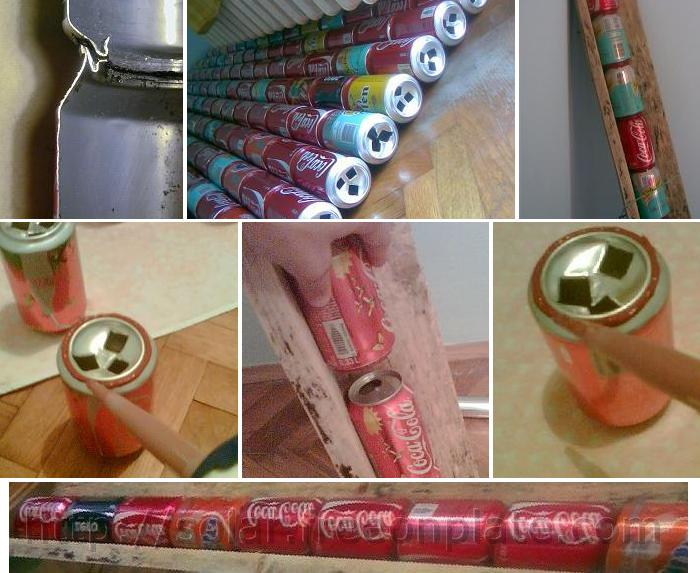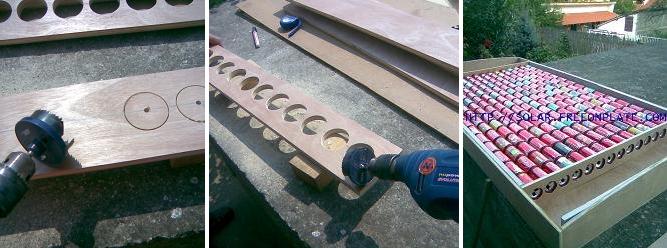
If you were told that you can build an inexpensive fully home-made solar panels instructed by a diy solar panel guide right in your backyard would you believe it? If you actually take the time to study the ingenious solar thermal systems today you will get to the conclusion that you actually can and is not as hard as you would have probably imagined, neither as expensive as you`ve imagined. Basically the simple solar system proposed uses indoor air directly to supplement home heating and the most extraordinary part is that this home build solar collector is realized out of empty recycled aluminium cans.
Today the renewable ecological energy sources are starting to spread yet non-ecological conventional ones are still producing enough electricity to set the tone of the entire world as the most important factor is directly related to profit. High profits are obtained by controlling strategic crude-oil reserves and as a result alternative energy will always come second until these will actually ran out.
By using this diy solar panel you will obtain the best results when it is sunny regardless of the outdoor temperature as the pop cans will gain heat rapidly. The fans will drive warm from the interior of the cans back into the room and if you want to achieve full autonomy or to auto-sustain yourself in remote locations you can simply add a PV solar panels or a wind generator and connect them to power the air blower.
Needless to say that if you are going to make the effort and gain your heat of a solar panels you should perform a few studies to make sure that your home insulation is able to withhold heat and that the loses are as small as possible. You can actually use a smaller solar system to heat up your home if the insulation is performing well.
DIY Solar Panel Assembling
The case that will nestle the solar panels will be realized out of wood of 0.6 in /15 mm while in the front a 0.12in / 3mm poly-carbonate or Plexiglas sheet or tempered glass can be used. The back of the solar panel will be insulated properly with a rock wool or styrodur of 20mm / 0.8 inch. You can use aluminium cans absorbs from different sources, whether they`re soda cans or beer cans it's irrelevant but all of them will be painted in matte black with a paint resistant to high temperatures. The top and bottom of each can will be pierced and bent in a special manner to ensure a highly efficient exchange between cans for the air flow.
Building the DIY Solar Panel Step by Step Guide
You should start by collecting the empty aluminium cans for the upcoming solar panel assembly. Do your best to wash them thoroughly because they will spread odors very quickly if you fail to do so. Make sure you use cans made out of aluminium, there are a few out there made of iron as well, make sure you have the right ones with a magnet.
Be insanely careful when you cut and shape the small fins at the top of each can as the whole point of this process it to induce turbulent airflow inside the pop cans so the the air passing through the tubes will collect as much heat as possible from the warm pop-can wall. It is recommended to cut the top of the can in the form of a start and distort three parts by using pliers as displayed in picture 1. Make sure all pop cans have received this treatment before you glue them together. Mark three holes on each one with a nail and drill the bottom by using tool similar to the ones showcased in the picture number 2 and 3.

Picture 1 Picture 2 Picture 3
Please execute these with caution as the procedure is extremely dangerous thanks to the thin wall of a tin can that cause injuries to your hands with ease. After the drilling is complete you can remove the excess parts with pliers.
It is recommended not to remove debris or sheets of metal with the bare hands and do your best to remove grease inside the cans as much as possible; using synthetic degrease agent will do the job with ease. All these steps should be realized either outdoors or in a very well ventilated room.
Keep in mind and be aware that procedure is flammable as well. Do not smoke or use any open flames near the work area.
In the next part you will start to glue all the cans together by using a silicone adhesive resistant to high temperatures of at least 200°C/400°F. On the market today you can find multiple solutions that can withstand temperature up to 300°C/570°F with ease. Top and bottom of all pop cans should be compatible and fit perfectly one onto another to ensure the air flow. Place just a little glue or silicone on the edges of the can and press it against the next one, this will ensure a great bonding without allowing the glue to run from the edge. In the Picture 4 below you can see the section of two pop cans glued together while an entire series of finished cans has been showcased in Picture 5.
Picture 4 Picture 5 Picture 6

Picture 7 Picture 8 Picture 9
Picture 10
It is time to create a template for stacking cans as the L profile shown in the Picture number 6. Two simple wooden planks nailed together can do the trick. You need this template to ensure the support for a solar pipe during the drying process. Moreover, you can secure the cans onto a template by using any ordinary jar rubber.
Pictures 7, 8 and 9 are displaying the gluing process. Picture 10 presents the pipe fixed in motionless position until the glue gets completely dry.

Picture 11 Picture 12 Picture 13
The exhaust boxes and intake for the solar panel will be realized out of either aluminium or wood of 1mm/0.04 in thickness as showcased in figures 11 and 12. The gaps around the edges should be secured with adhesive tap or heat resistant silicone. In the next step 55mm /2.6 in diameter cut outs will be drilled on one side of the intake/exhaust box as you can see in the Pictures 12 and 13, here the first rows of cans will be glued to the air exhaust/intake boxes. You can see all the parts already assembled awaiting the painting process in figure 13.
Keep in mind that the adhesive is drying very slowly and it should be let to rest at least 24 hours.
Solar absorbers will fit in the casing made out of wood in the Picture 14 and the back side of the diy solar panel will be made out of plywood. The insulation can be seen in Figure 15 and it will be realized out of either rock wool or styrodur. Be careful when you insulate around the openings for the solar collector air inlet/outlet.
Preparations, protection and painting of the box comes next. Special hooks can be attached in all the four corners to ensure that the solar collector can be mounted easily on the wall as in Image 16 but using 10mm/0.4in screws, Figure 17. The empty box is positioned for marking and drilling for air inlet/exhaust.
Picture 14 Picture 15 Picture 16 Picture 17

Picture 18 Picture 19 Picture 20
In the end the solar absorbers will be painted in matte black and be positioned inside the housing. Covering the solar panel with plexiglas secured through silicone comes next. Keep in mid that polycarbonate and plexiglass is slightly convex and will offer the construction additional strength. In the Figure 18 you can see the solar absorber without plexiglass while the complete solar colector is shown in Picture 19 and finally the installed element is showcased in Picture 20.
Take as example the pop-can diy solar panels on YouTube. Video shows how solar panel operates on a bright day. After first 20 minutes, panel raised the air temperature inside living room to 50°C/122°F.
Keep in mind that this solar thermal system will not be able to retain thermal energy after it produces it. When it`s sunny outside the solar collector will produce heat yet it is necessary to use it immediately to heat the room. In the same manner if the sun does not shine you should intrerrup the air supply as it will slowly cool off the room. You can install a shut off valve will which can reduce unnecessary heat loss to avoid this incident.
You can also improve this installation with different electronic components bought from various stores. A differential thermostat can help you reglate the temperatures if you need more comfort. Keep in mind that if the on/off temperatures will be calculated carefully this diy solar panel is able to produce an average of 2 kW of energy for home heating.
Important note: This solar thermal system is not able to accumulate thermal energy after producing it. When it’s sunny, solar collector produces heat, but it is necessary to use it immediately for heating the room. If the sun does not shine, it is necessary to interrupt the air supply to the solar collector, otherwise the room will begin to slowly cool off. This can be solved by installing shut-off valve, which will reduce unnecessary heat loss.
Differential thermostat (snap disc) controls the fan. This thermostat can be bought in better-equipped electronic component stores. Thermostat has two sensors. One placed inside the top opening for warm air, the other inside the lower opening for the supply of cold air in the solar collector.
If on/off temperatures are set carefully, diy solar panels are able to produce an average 2 kW of energy for home heating. This generally depends on how much sun do we have during the day.
Solar Panel Test Drive
The solar collector dress rehearsal can be conducted in the backyard before installing the system on the house. Do the procedure in a sunny day without clouds. The air blower used in this project has actually been a PC cooler salvaged from a faulty power source of a personal computer so do not spend to much on these components. After 10 minutes in the sun from the solar collector is out hot air temperatures of 70°C/158°F! Needless to say that test results have pushed us to install solar heaters on the house as soon as possible.
Soon after the installation of the collector has been finished the outside temperature was -3°C/26°F and the element was blowing 3 m3/min (3 cubic meters per minute) of warm air. For the end result a more powerful fan has been used. Heated air temperature went up to a staggering +72°C/162°F and the temperature has been registered with a digital thermometer. To calculate total heating power of the collector, the calculation of the air flow and average air temperature on output. Calculated power which DIY solar panels produced, was almost 1950 W watts which is almost 3 HP
In conclusion the results have been extremely rewardful and we would dare to say that these DIY solar panels are definitely worth making. The collector at least can be used to complement your power source in order to save a huge amount of money.
Photo Courtesy to freeonplate.com
